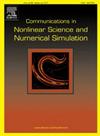A thermodynamically consistent discretization of 1D thermal-fluid models using their metriplectic 4-bracket structure
IF 3.4
2区 数学
Q1 MATHEMATICS, APPLIED
Communications in Nonlinear Science and Numerical Simulation
Pub Date : 2025-02-24
DOI:10.1016/j.cnsns.2025.108683
引用次数: 0
Abstract
Thermodynamically consistent models in continuum physics, i.e. models which satisfy the first and second laws of thermodynamics, may be expressed using the metriplectic formalism. In this work, we leverage the structures underlying this modeling formalism to preserve thermodynamic consistency in discretizations of a fluid model. The procedure relies (1) on ensuring that the spatial semi-discretization retains certain symmetries and degeneracies of the Poisson and metriplectic 4-brackets, and (2) on the use of an appropriate energy conserving time-stepping method. The minimally simple yet nontrivial example of a one-dimensional thermal-fluid model is treated. It is found that preservation of the requisite symmetries and degeneracies of the 4-bracket is relatively simple to ensure in Galerkin spatial discretizations, suggesting a path forward for thermodynamically consistent discretizations of more complex fluid models using more specialized Galerkin methods.
求助全文
约1分钟内获得全文
求助全文
来源期刊

Communications in Nonlinear Science and Numerical Simulation
MATHEMATICS, APPLIED-MATHEMATICS, INTERDISCIPLINARY APPLICATIONS
CiteScore
6.80
自引率
7.70%
发文量
378
审稿时长
78 days
期刊介绍:
The journal publishes original research findings on experimental observation, mathematical modeling, theoretical analysis and numerical simulation, for more accurate description, better prediction or novel application, of nonlinear phenomena in science and engineering. It offers a venue for researchers to make rapid exchange of ideas and techniques in nonlinear science and complexity.
The submission of manuscripts with cross-disciplinary approaches in nonlinear science and complexity is particularly encouraged.
Topics of interest:
Nonlinear differential or delay equations, Lie group analysis and asymptotic methods, Discontinuous systems, Fractals, Fractional calculus and dynamics, Nonlinear effects in quantum mechanics, Nonlinear stochastic processes, Experimental nonlinear science, Time-series and signal analysis, Computational methods and simulations in nonlinear science and engineering, Control of dynamical systems, Synchronization, Lyapunov analysis, High-dimensional chaos and turbulence, Chaos in Hamiltonian systems, Integrable systems and solitons, Collective behavior in many-body systems, Biological physics and networks, Nonlinear mechanical systems, Complex systems and complexity.
No length limitation for contributions is set, but only concisely written manuscripts are published. Brief papers are published on the basis of Rapid Communications. Discussions of previously published papers are welcome.
 求助内容:
求助内容: 应助结果提醒方式:
应助结果提醒方式:


